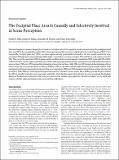| dc.contributor.author | Dilks, Daniel D. | |
| dc.contributor.author | Julian, Joshua B. | |
| dc.contributor.author | Paunov, Alexander M. | |
| dc.contributor.author | Kanwisher, Nancy | |
| dc.date.accessioned | 2013-08-23T16:35:39Z | |
| dc.date.available | 2013-08-23T16:35:39Z | |
| dc.date.issued | 2013-01 | |
| dc.date.submitted | 2012-11 | |
| dc.identifier.issn | 0270-6474 | |
| dc.identifier.issn | 1529-2401 | |
| dc.identifier.uri | http://hdl.handle.net/1721.1/80268 | |
| dc.description.abstract | Functional magnetic resonance imaging has revealed a set of regions selectively engaged in visual scene processing: the parahippocampal place area (PPA), the retrosplenial complex (RSC), and a region around the transverse occipital sulcus (previously known as “TOS”), here renamed the “occipital place area” (OPA). Are these regions not only preferentially activated by, but also causally involved in scene perception? Although past neuropsychological data imply a causal role in scene processing for PPA and RSC, no such evidence exists for OPA. Thus, to test the causal role of OPA in human adults, we delivered transcranial magnetic stimulation (TMS) to the right OPA (rOPA) or the nearby face-selective right occipital face area (rOFA) while participants performed fine-grained perceptual discrimination tasks on scenes or faces. TMS over rOPA impaired discrimination of scenes but not faces, while TMS over rOFA impaired discrimination of faces but not scenes. In a second experiment, we delivered TMS to rOPA, or the object-selective right lateral occipital complex (rLOC), while participants performed categorization tasks involving scenes and objects. TMS over rOPA impaired categorization accuracy of scenes but not objects, while TMS over rLOC impaired categorization accuracy of objects but not scenes. These findings provide the first evidence that OPA is causally involved in scene processing, and further show that this causal role is selective for scene perception. Our findings illuminate the functional architecture of the scene perception system, and also argue against the “distributed coding” view in which each category-selective region participates in the representation of all objects. | en_US |
| dc.description.sponsorship | National Institutes of Health (U.S.) (Grant EY013455) | en_US |
| dc.language.iso | en_US | |
| dc.publisher | Society for Neuroscience | en_US |
| dc.relation.isversionof | http://dx.doi.org/10.1523/jneurosci.4081-12.2013 | en_US |
| dc.rights | Article is made available in accordance with the publisher's policy and may be subject to US copyright law. Please refer to the publisher's site for terms of use. | en_US |
| dc.source | SFN | en_US |
| dc.title | The Occipital Place Area Is Causally and Selectively Involved in Scene Perception | en_US |
| dc.type | Article | en_US |
| dc.identifier.citation | Dilks, D. D., J. B. Julian, A. M. Paunov, and N. Kanwisher. “The Occipital Place Area Is Causally and Selectively Involved in Scene Perception.” Journal of Neuroscience 33, no. 4 (January 23, 2013): 1331-1336. | en_US |
| dc.contributor.department | Massachusetts Institute of Technology. Department of Brain and Cognitive Sciences | en_US |
| dc.contributor.department | McGovern Institute for Brain Research at MIT | en_US |
| dc.contributor.mitauthor | Dilks, Daniel D. | en_US |
| dc.contributor.mitauthor | Julian, Joshua B. | en_US |
| dc.contributor.mitauthor | Paunov, Alexander M. | en_US |
| dc.contributor.mitauthor | Kanwisher, Nancy | en_US |
| dc.relation.journal | Journal of Neuroscience | en_US |
| dc.eprint.version | Final published version | en_US |
| dc.type.uri | http://purl.org/eprint/type/JournalArticle | en_US |
| eprint.status | http://purl.org/eprint/status/PeerReviewed | en_US |
| dspace.orderedauthors | Dilks, D. D.; Julian, J. B.; Paunov, A. M.; Kanwisher, N. | en_US |
| dc.identifier.orcid | https://orcid.org/0000-0003-4342-0534 | |
| dc.identifier.orcid | https://orcid.org/0000-0003-3853-7885 | |
| mit.license | PUBLISHER_POLICY | en_US |
| mit.metadata.status | Complete | |
